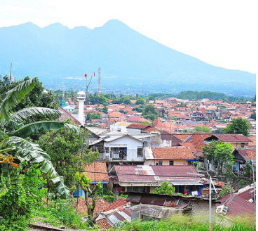Case-study /
INSIDE STORY: Treading low-carbon pathways toward sustainability – the experience of Bogor City

Introduction
Since 2013, the Urban Low Emission Development Strategies (Urban-LEDS) project has offered Bogor City an opportunity to integrate low-carbon strategies not just in the transport sector but in its local development plans, supporting the city’s vision of adopting sustainability to transform Bogor into a more liveable city.
The project introduced ICLEI’s GreenClimateCities framework, using the analyse–act–accelerate model to offer customised guidance to Bogor City. Within 2.5 years of continuous engagement and capacity building, and numerous exchange visits with other participating countries, Bogor City’s low-carbon plan has been developed and is now ready to move towards implementation.
This Inside Story* describes:
- How the way was ‘paved’ for Bogor’s low carbon development pathway;
- the challenges and enabling factors; and
- the implications for decision-makers and practitioners elsewhere.
*download the full text from the right-hand column or via the link provided under further resources. The Key Messages are provided below.
Key Messages
-
The Urban-LEDS project highlights the importance of combined efforts by technical departments and local chief executives in moving from planning to implementation.
-
The completion of Bogor City’s greenhouse gas emissions inventory allowed the city government to prioritise low-carbon options and identify concrete implementable projects such as pedestrianisation and streetlight retrofitting.
-
Embedding LEDS considerations into long-term development plans can allow a local government to allocate funds for LEDS-related activities as evidenced by Bogor City’s experience. The Urban-LEDS project integrated LEDS when formulating the city’s regional medium-term plan resulting in a commitment of financial support for LEDS activities from the city budget.
-
Projects should be examined from a macro perspective and not implemented in isolation. It is important for implementers to conduct an intervention mapping in consultation with the city government in order to maximise linkages and synergies, and align projects with long-term development plans to ensure sustainability and ownership.
-
There is value in networking. South–South–North exchanges enriched Bogor City’s experience of integrating LEDS in its own development plans by looking at how developed European cities did it and simultaneously learning along with other emerging secondary cities under the Urban-LEDS project.
CDKN has a growing portfolio of work in states, provinces, cities and districts. It is committed to capturing the lessons learned, and to better understanding what makes low-carbon and climate-resilient development efforts work well at the subnational level. CDKN and ICLEI – Local Governments for Sustainability have set up a joint learning programme to distil and share these lessons with others. This Inside Story is one output of the learning programme. For more in the series, visit www.cdkn.org/cdkn_series/inside-story
This Inside Story was written by Ranell Martin M. Dedicatoria, ICLEI Southeast Asia Secretariat and Irvan Pulungan, ICLEI Indonesia Project Office.
Suggested Citation
Dedicatoria, R. M. and Pulungan, I. (2016) Treading low-carbon pathways toward sustainability: The experience of Bogor City. INSIDE STORIES on climate compatible development. Climate & Development Knowledge Network: London, UK.
- View this INSIDE STORY on CDKN's website
- Read about mainstreaming climate compatible development
- Read more work on low emissions development via the LEDS GP organisation page (scroll down for resources)
